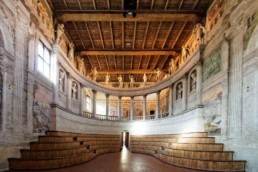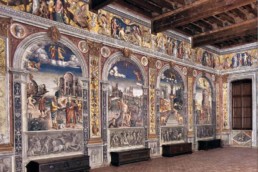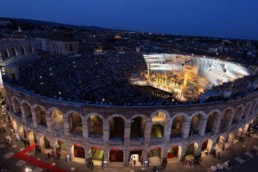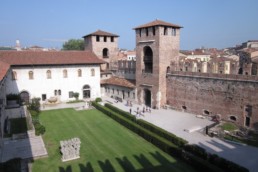Thursday, 18 May 2017
9.00 am
Transfer to Sabbioneta
10 – 11,30 am
Sabbioneta
Sightseeing tour of Sabbioneta and its renaissance buildings
The theatre and Palazzo Ducale will be visited with the members of the World Federation of Friends of Museums after the plenary session.
Sabbioneta was founded by will of Vespasiano Gonzaga Colonna (ab urbe condita, 1556 – 1591), condottiere, enlightened and cultivated prince and a scholar of Vitruvius. It was the capital city of the tiny Gonzaga duchy: well protected by the ramparts of the strong, star-shaped walls whose project is attributed to Vespasiano himself, Sabbioneta was also a modern hub for art and culture, a sort of “small Athens”. The walls still guard the checkerboard urban structure as well as the sophisticated XVI century buildings. Among the most interesting parts, the gateways called Imperiale and della Vittoria, Galleria degli Antichi, the Theatre, Palazzo Ducale – the first major building ever built in Vespasiano’s new city – and the archpriest church of Santa Maria Assunta. Other noteworthy landmarks are the “Casino” or Palazzo Giardino, the duke’s otium sanctuary, Colonna della dea Pallade, a statue of Adrian or Anton age purchased on the antiquity market by Vespasiano, and the church of Incoronata, a Ducal mausoleum where in the summer of 1988 the restoration works unveiled the tomb of Vespasiano Gonzaga.
1.00 – 2.00 pm
Cantine di Palazzo Ducale
Buffet lunch with the companions
2,30 pm
Transfer to Mantua
3.00 – 4.30 pm
Mantua, Palazzo Te – site tour with the Delegates’ group
Palazzo Te is considered the masterpiece of Giulio Pippi de’Jannuzzi, also know as Giulio Romano. The main architecture and the palace’s decorative structure were inspired by the Roman domus, and were entirely made between 1525 and 1535 in an area right outside of the city and commissioned for the “leisurely time” of Federico II Gonzaga. In spite of the several restoration projects over the centuries, Palazzo Te is one of the most outstanding and better-preserved Renaissance buildings of Europe. There, Giulio collected his profound knowledge of classical culture and his flawless mastery of the contemporary greats, from Raphael to Michelangelo, not to mention his ingenious, ground-breaking inventions that still impress visitors.
4.30 – 6.30 pm
Return transfer to the hotels, free time
6.30 pm
Transfer to Mantua
7.30 – 8.45 pm
Mantua, Palazzo Ducale, Garden of Simples
Welcome drink
Garden of Simples (herb garden) in The Ducal Palace was wanted by Vincenzo I Gonzaga, fourth Duke of Mantua. Recently the Garden has been redesigned according to the plan and plants chosen in 1603 by the naturalist and botanist Zanobi Bocchi. The Garden has an “esoteric” dimension, intimate and sacred at the same time. The square form, divided in four parts, recalls the four corners of the world, and also the four Elements, the four seasons, the four Humours, the phases of the Alchemical Teaching which aimed to achieve the immortality Elixir. In the center, on the intersection of the diagonal lines, is located a water tank from which, allegorically, were flowing the four rivers of Eden.
8.45 pm
Mantua, Teatrino Scientifico dell’Accademia
Concert in honour of the World Federation of Friends of Museums
Teatro dell’Accademia was commissioned by Mantua academics to architect and stage designer Antonio Galli Bibiena in 1767 to house scientific exhibitions, cultural conferences and music performances. The superb Baroque architect conceived a stunning theatre hall in the shape of a bell, with 3 tiers of boxes, which he personally decorated with monochrome frescoes. Thanks to the perfect acoustics it is one of the most coveted venue among chamber musicians for their performances and recording sessions.
A few months after the opening, a thirteen-year old Wolfgang Amadeus Mozart performed in this venue. His father Leopold wrote his wife that he had seen “the most beautiful theatre in the world”.
Return transfer to the hotels
Teatro di Vincenzo Scamozzi: The theatre was designed in 1588 by architect Vincenzo Scamozzi for Vespasiano Gonzaga Colonna, Duke of Sabbioneta. The innovative entrance system, the mixed profile of the cavea, and the changing rooms for actors and orchestra players at the back of the stage, puts it among the most prominent examples among European theatres. Sabbioneta.
Friday, 19 May 2017
8.45 am
Transfer to Mantua
10.00 am -12.30 pm
Mantua
History and art tour of the city centre of Mantua, with particular regard for the Basilica di Sant’Andrea
The tour will touch the UNESCO world heritage city’s two oldest districts: the civitas vetus, comprised between the Cathedral and lake Inferiore, and civitas nova, with the centres of communal-age power, upon which the Gonzaga left their monumental mark.
Over the century the old town became the secluded and exclusive centre of the Signoria, with the original buildings giving on to the austere and vast Piazza Sordello (originally Piazza San Pietro) and the wing of Palazzo Ducale stretching all the way to the lake.
Through the Volto di San Pietro the old town connects with the communal-age part, which stands out for its squares and porticoed mercantile streets. This is where old communal buildings are still found: Palazzo Della Ragione, Palazzo del Podestà, the Arengario. Here in the V century was the working ground of Marquis Ludovico’s architects, whose most impressive outcomes include the Torre dell’Orologio and Basilica di Sant’Andrea, designed by Leon Battista Alberti to house the relic of Preziosissimo Sangue di Cristo, of which the people of Mantua consider itself as the true guardian.
Alberti’s construction site, a masterpiece and example of Renaissance architecture, remained unfinished. In the following centuries Antonio Maria Viani added a crypt to house the holy relic and in the XVIII century Filippo Juvara designed the grand dome that currently towers over the city.
The morning tour will end with a visit of Museo Diocesano “Francesco Gonzaga”, a beautiful XV century building remodelled in neoclassical time featuring a unique collection including the set of Italian XV century armours, painted enamels, the Paris tapestries of Henri Lerambert – Henry IV’s court painter – and Barbara of Brandenburg’s (1442 – 1465) extraordinary missal illuminated by Belbello da Pavia and Girolamo da Cremona
1.00 pm
Lunch at Palazzo Arrivabene
Historical building built by the powerful family Arrivabene and designed by tuscan architect Luca Fancelli in 1481. Outside, the inscription with dating and coat of arms of the Arrivabene family. Inside, elegant halls with XVIII century frescoes attributed to Giuseppe Bazzani.
2,30 pm
Tour of Palazzo d’Arco
The house of the Counts of D’Arco, as appears in its current neoclassical form, was built after 1784 by commission from Gherardo D’Arco. The project was tasked to neoclassical architects Antonio Colonna and Paolo Pozzo. In the 1870s Countess Giovanna, the last heir of the noble house, bequeathed the building to the City of Mantua.
The palace looks as though it was still inhabited. The painting gallery has a remarkable collection, with works of art from the XV to the XVIII century, from Niccolo’ da Verona to Rubens, Van Dick, Luini, Sodoma, Bazzani, and Magnasco. The XIX century kitchen with its copper ware collection is quite interesting. Besides the semi-circular portion of the parade ground, the palace also features a romantic garden, the XVI century buildings that house Antonio d’Arco’s natural science collection and the Giovanni Maria Falconetto’s early XVI century grand fresco cycle at Sala dello Zodiaco.
4.00 pm
Tour of Teatrino Scientifico dell’Accademia
Palazzo dell’Accademia is a building designed by Giuseppe Piermarini as the seat of the “Royal Academy of Science, Literature and Art”, under the tutelage of Empress Maria Theresa of Austria. Over time the institution came to be known as the “Accademia Nazionale Virgiliana”. The upper floor houses the beautiful Accademici meeting room, also known as Piermarini room, designed in 1775 by architect Paolo Pozzo. The plasticity of the ornaments, made by Stanislao Somazzi on a design by Giuseppe Bottani, is particularly exquisite. Three large canvases by Hubert Maurer celebrate the Imperial Family.
5.00 pm
Mantua, Palazzo Ducale, sightseeing tour for Delegates and Companions
The oldest part of Palazzo Ducale is known as Corte Vecchia. First it was occupied by the Bonacolsi and then, after dal 1328, by the Gonzaga family, which kept it as its residence until 1459, when Marquis Ludovico Gonzaga moved to Castello di San Giorgio. Under Ludovico’s rule the Castle became the emblem of Renaissance culture: the most significant example is the unparalleled Camera Picta or degli Sposi, where Andrea Mantegna worked between 1465 and 1474. The most outstanding exhibits at Corte Vecchia include Sala del Pisanello, with the Lancelot fresco, a Breton romance about the antics of the Knights of the Round Table, Sale degli Arazzi, with new, very precious Flemish tapestries woven on Raffaello Sanzio’s paper models for the Sistine Chapel and produced with a personalised hem for Cardinal Ercole Gonzaga, Isabella d’Este Gonzaga’s widow quarters and the famous studio, the secret garden, and the Grotta.
The block of buildings built on the side of lake Inferiore is called Corte Nuova. The most outstanding examples include buildings by Giulio Romano and Giovanni Battista Bertani such as the Appartamento di Troia, the charming Palazzina della Rustica, the lush Galleria della Mostra, and the grand Sala di Manto, Duke Guglielmo’s Salle des Fêtes. Also for Guglielmo, a Duke and a musician, in 1563 Giovanni Battista Bertani started constructing the building’s visual fulcrum: the palatine church of Santa Barbara and its incredible acoustics.
At the end of the tour, farewell cocktail at ‘Cortile d’Onore’
Return transfer to the hotels
The Palazzo D’Arco is a Neoclassical-style palace located in Mantova. The palace houses the Museo di Palazzo d’Arco, which displays the furnishings and artwork collected by the Duke D’Arco
Saturday, 20 May 2017
10.00 am -12.30 pm
Verona
Guided tour of the Cathedral, Santa Anastasia and walk in Giardino Giusti
The cathedral of Verona and the adjacent church buildings is the outstanding continuation of the early, IV century Christian settlements. The articulate architectural complex surrounds the archaeological site – with traces of the first paleo-Christian basilica – around the majestic and imposing Cathedral, as well as the church of Sant’Elena, consecrated in 813, the little Basilica di San Giovanni in Fonte and the cloister.
In turn, Santa Anastasia stands as the most important example of a gothic church in the city. Its magnificent portal, the grand interior divided into three naves and the works of art it houses – including Pisanello’ ‘San Giorgio e la Principessa’ – make a jewel you should not miss.
End-of-the-morning walk in the green landscape of Giardino Giusti, a magnificent example of a Renaissance Italian garden.
1.00 pm
Buffet lunch at the Accademia Filarmonica di Verona with the Delegates’ group
3.00 pm
A city sightseeing tour with the Delegates’ group
A guided walk in the centre of Verona, with stops by the main landmarks and symbols of the city’s history as well as the most remarkable monuments and art testimonies: the Arena, Piazza Erbe, Juliet’s balcony, Piazza dei Signori, Arche Scaligere, Ponte Pietra and a visit of the archaeological museum at Colle di san Pietro with a spectacular view on the city.
The tour will start on foot from Piazza Bra and will stop first at the Arena, the most significant testimony of Roman-time Verona: the amphitheatre is known all over the world for its beauty, pristine preservation and opera programme. From here the tour crosses Via Mazzini to reach the heart of medieval Verona and the beautiful Piazza Erbe, fenced on all sides by ancient, Communal and Scaliger-time buildings. Then homage to Shakespeare will be paid with a visit at ‘Juliet’s balcony’, and then on to Piazza dei Signori to admire Arche Scaligere, a jewel of northern Italy gothic sculpture and architecture. Finally, the group will cross Ponte Pietra, the city’s oldest bridge dating back to Roman times, and reach the Roman theatre and the Archaeological museum, located in a magnificent panoramic location.
5.30 pm
Return to the hotels
8.00 pm
Reception at Palazzo Canossa, Verona, with welcome by Marquis Guidalberto and Marchioness Isabella di Canossa
Palazzo Canossa, still the property of the family, was built after 1530 by commission from Lodovico di Canossa, bishop of Bayeux, and his nephews on a design by Verona architect Michele Sanmicheli. It is one of the city’s most significant examples of Renaissance architecture thanks to its layout, façade and ground floor ashlar work, not to mention the large open hall with three arches giving on to the street. Inside, the palace still displays original furniture, frescoes and paintings.
The Verona Arena is a Roman amphitheatre in Piazza Bra in Verona, Italy built in the first century. It is still in use today and is internationally famous for the large-scale opera performances given there.
Sunday, 21 May 2017
10.00 am -12.30 pm
Guided tour of Museo di Castelvecchio
The city museum is located in the castle the Scaliger family built after 1354. The current layout was made by Carlo Scarpa who, between 1957 and 1964 transformed and impressed his own original style on the entire building and the arrangement of the collection it treasures. Scarpa’s work in Castelvecchio is still being studiesd by architects all over the world. The Castle walkways offer a beautiful sight on the city centre and the Adige River.
1.00 12.30 pm
Farewell Lunch at the Accademia Filarmonica di Verona with the Delegates’ group
3.00 – 5.00 pm
Walk along the Adige to Basilica di San Zeno and guided tour of the abbey with the Delegates’ group
Basilica di san Zeno and the adjacent Abbey tower and bell tower, is one of the most outstanding Romanic-style buildings in northern Italy. The façade stands out for the large rose window and the famous porch supported by two lions, carved towards the end of the XII century. The inside of the basilica is no less majestic with three large naves, a crypt, several frescoes and as a final treat, a table by Mantegna portraying ‘Mary on a throne with the Baby and the Saints’, a masterpiece of mid-XV century Italian art and a milestone of Italian art history.
A shuttle service will be available for the transfers between Verona and Mantua



